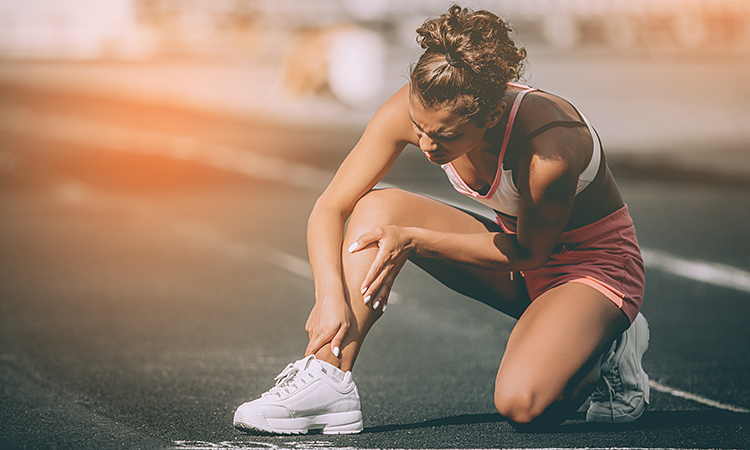As a certified athletic trainer and licensed massage therapist, I have worked with many athletes in my 20-year career.
In the NCAA Division I collegiate setting as an athletic trainer, one of the sports I worked was track and field, in which I saw injuries ranging from hamstring strains to stress fractures. Many years later as a business owner of a wellness center, I saw marathon runners and weekend warriors come through my establishment for various running injuries.
The most common injuries my staff saw regularly were iliotibial band (ITB) syndrome, hamstring strains and plantar fasciitis. Incorporating sports medicine treatments along with massage therapy techniques proved to work well together to assist in the recovery and healing of those injuries.
1. Iliotibial Band Syndrome
ITB syndrome is a common injury of the lateral aspect of the thigh and occurs due to activities including running.
During running, the muscles of the thigh become engorged with blood and expand. The expansion creates extra pressure on the band, causing the band to flip over the lateral epicondyle of the femur. This constant flipping starts to inflame the band and causes pain and discomfort.
ITB syndrome is best treated with therapeutic or massage therapy techniques to the muscles surrounding the band. Using cupping therapy and stretch therapy to tensor fasciae latae, ITB insertion point and gluteus medius while the client is in a side-lying position with the treated side being on top allows the sports massage therapist to use passive stretching while stabilizing the hips. Passively move the client’s top leg anteriorly, posteriorly and then medially toward the table holding each position for 30 seconds.
Once the treatment is complete, the client’s hip will be loose and relief to the band will be noticed immediately.
2. Hamstring Strain
Hamstring strain is also known as a pulled hamstring muscle. The hamstrings can be overpowered by the quadriceps muscles, so if the hamstring becomes tight the force of the quadriceps’ contraction can overpower and pull the hamstrings.
Most individuals’ quad muscles are known to be stronger than their opposing muscle, the hamstrings. Women, especially, are known to be quad dominant. Weak hamstring muscles will become a liability and eventually will lead to injury.
Hamstring strains are best addressed using Instrument Assisted Soft Tissue Mobilization (IASTM) tools. These tools break down adhesions and provide arterial blood flow to the area to assist with the healing process.
The sports massage therapist should also administer passive static stretching to hip muscles in all planes. Once a client is two to three weeks out from the initial injury, introducing Proprioceptive Neuromuscular Facilitation (PNF) stretching techniques to the treatment will work well.
3. Plantar Fasciitis
Plantar fasciitis will typically present itself as sharp pain in the heel or in the arch of the foot, most often when the client is taking the first steps of the day. The pain is the result of the plantar fascia—the thick band of tissue connecting your heel to the ball of your foot—becoming inflamed due to overuse.
The inflammation that causes plantar fasciitis can come from a sudden increase in activity levels. Other causes may include running, a lot of standing, walking or running on hard surfaces, not wearing shoes that properly support your foot type, or being overweight.
Plantar fasciitis treatments include stretching and using an IASTM tool. Stretching—the soles of the client’s foot by gently pulling their big toe back toward their ankle and stretching the calves as well—is also effective.
Tight calves may also make the client more susceptible to plantar fasciitis. Using an IASTM tool on the plantar side of the foot, especially toward the heel, will help break down adhesions.
Providing the client with a home-exercise program by instructing them to use a tennis ball to massage the bottom of the foot can do wonders. Tell the client to roll a tennis ball under the sole of their foot, applying weight as comfort allows. Rolling the foot over a frozen plastic water bottle can also work, with the added benefit of helping decrease pain and inflammation.
Sports Massage: RICE
General treatment to any acute injuries for 24 to 48 hours after injury is RICE: rest, ice, compression and elevation. During this time, no hands-on treatment is allowed.
Once the acute phase has subsided, the client has been diagnosed by a medical practitioner with one of the three injuries mentioned above, and has been cleared to receive manual therapy, the techniques described above should provide relief.
About the Author
A respected health and wellness practitioner and an acclaimed educator, Davonna M. Willis, ATC, LMT, owns 4 Nineteen Education & Training, where she teaches a variety of massage curricula, marketing and business strategies to new business enterprises. Willis has over 20 years of experience in the field of health and wellness.
